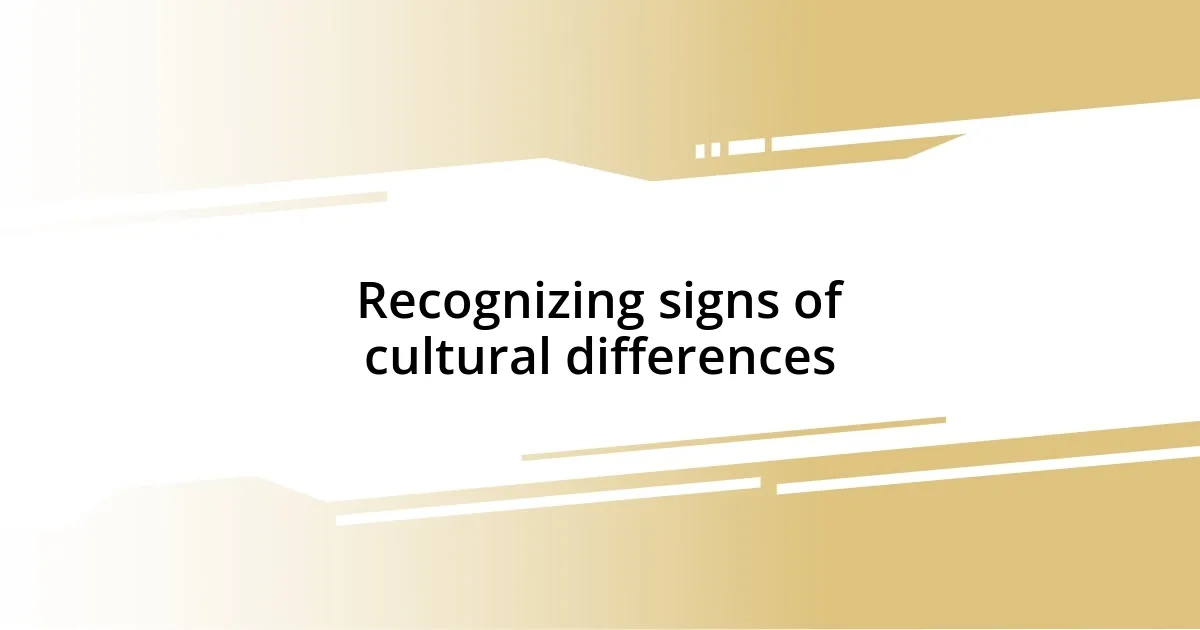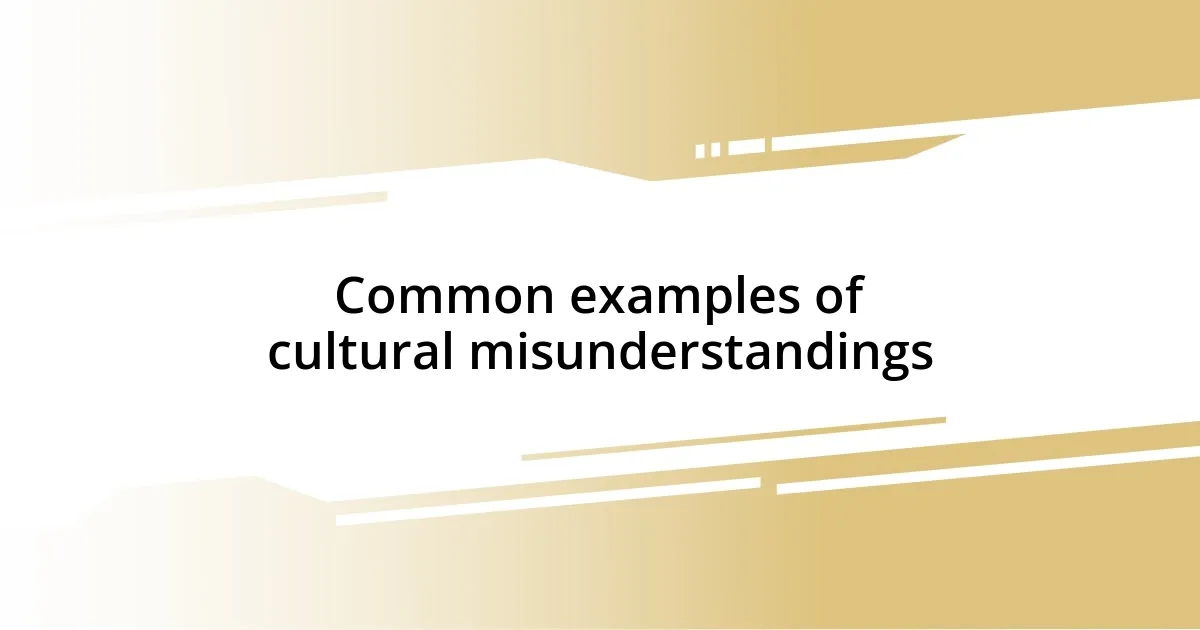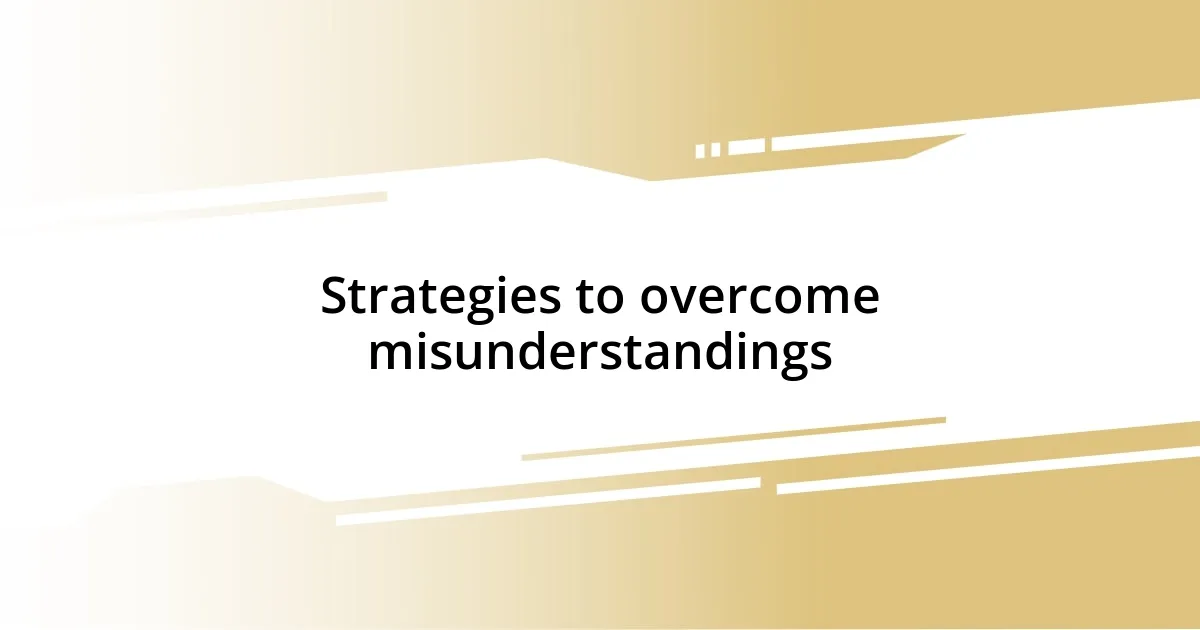Key takeaways:
- Cultural misunderstandings often arise from assumptions about universal norms, highlighting the need for open-mindedness and curiosity in cross-cultural interactions.
- Non-verbal cues and gestures carry different meanings across cultures, affecting communication and engagement.
- Adapting to cultural differences, such as dining customs and concepts of time, enriches experiences and fosters deeper connections.
- Active listening and encouraging open dialogue are essential strategies for overcoming misunderstandings in multicultural settings.

Understanding cultural misunderstandings
Cultural misunderstandings often stem from deeply rooted beliefs and practices that shape our views. I remember a time when I innocently asked a friend about her traditional attire during a festival, only to realize that my question touched on a sensitive subject about her family’s history. How often do we overlook the intricacies of another culture, assuming our perspective is universal?
It’s fascinating how something as simple as a gesture can carry different meanings across cultures. For instance, a thumbs-up in one country might signify approval, while in another, it could be seen as an insult. I found myself in an awkward situation once when I used this gesture in a conversation, completely unaware of its negative connotation. It makes me wonder, how many relationships have been strained over similar misinterpretations?
Understanding cultural nuances requires an open mindset and a willingness to learn. Personally, I’ve come to appreciate the beauty in asking questions, no matter how uncomfortable they may seem. Isn’t it incredible how a simple conversation can bridge gaps and foster deeper connections? Engaging with different perspectives has totally transformed how I view the world around me.

Recognizing signs of cultural differences
Recognizing signs of cultural differences can be an eye-opening experience. I once attended a dinner where the dining customs were strikingly different from my own. The way my hosts approached meal times—with a focus on communal sharing—was something I hadn’t experienced before. I felt a bit lost initially, but it taught me how deeply culture can influence even the smallest of actions.
In my travels, I’ve learned to pay attention to non-verbal cues. For example, during a visit to Japan, I noticed that bowing was a sign of respect and greeting, rather than a casual handshake. This subtle shift in greeting immediately reminded me how important it is to adapt and respect the norms of others. Have you ever noticed a situation that caused you to rethink how you interact based on cultural context?
Another significant sign of cultural differences is the approach to time and punctuality. While I grew up in a culture that values being on time, I’ve encountered places where flexibility is more appreciated. I remember a meeting starting over an hour late, and rather than feeling frustrated, I realized this was an invitation to relax and enjoy the moment. It challenged my preconceived notions about efficiency and prompted a deeper understanding of the value placed on relationships over strict schedules.
| Aspect | Significance |
|---|---|
| Dining Customs | Influences how people share meals and connect socially. |
| Non-Verbal Communication | Cues like gestures and greetings vary greatly and convey deep meanings. |
| Concept of Time | Affects expectations around punctuality and the flow of interactions. |

Common examples of cultural misunderstandings
Common cultural misunderstandings can arise in everyday situations, often revealing how varied our norms can be. I recall a job interview where I mistakenly thought making direct eye contact demonstrated confidence, only to discover later that in some cultures, this can be perceived as being confrontational. It left me feeling embarrassed and made me realize how easy it is to misinterpret such social cues.
Here are some common examples:
- Personal Space: In some cultures, people stand close during conversations; in others, maintaining distance is a sign of respect.
- Gift Giving: The significance of gifts can vary—what is a generous gesture in one culture might be considered inappropriate in another.
- Small Talk: While some cultures value casual conversation as a way to build rapport, others may see it as a waste of time and prefer to get straight to the point.
- Criticism: Direct criticism may be standard in one culture, while in another, it could be seen as deeply offensive and disrespectful.
- Dress Codes: The interpretation of casual versus formal attire can differ significantly, leading to uncomfortable situations.
These nuances can be subtle, but they highlight the rich tapestry of cultural expression. I find myself often reflecting on my own experiences, realizing that even the simplest of interactions can sometimes lead to understanding or, unfortunately, misunderstandings. It truly emphasizes the importance of approaching cultural exchanges with an open heart and mind.

Strategies to overcome misunderstandings
To bridge the gap in cultural misunderstandings, I’ve found that open dialogue is key. Recently, I was part of a multicultural team project where assumptions could easily have led to friction. By encouraging everyone to share their perspectives and asking clarifying questions, we were able to foster a supportive environment. Isn’t it amazing how just a few candid conversations can prevent a myriad of misunderstandings?
Another strategy I’ve embraced is the practice of active listening. During a meeting with colleagues from a culture that values indirect communication, I realized I had to listen carefully for deeper meanings beneath their words. This approach not only enriched my understanding but also helped me feel more connected to my team. Have you ever noticed how taking a moment to truly listen can reveal what’s unsaid?
Lastly, I find that being adaptable is essential in multicultural settings. I remember attending a festival where certain behaviors, such as loud laughter, were deemed inappropriate. By adjusting my actions to fit in with the expected decorum, I not only gained respect but also felt more integrated into the community. Learning to pivot based on the cultural context isn’t just a skill; it can transform your experiences into something deeply rewarding.

Communicating effectively across cultures
When it comes to communicating across cultures, I personally believe that showing genuine curiosity about others’ backgrounds can work wonders. I once had a lunch with a colleague from Japan, and instead of diving straight into work discussions, I asked about local customs. Her face lit up as she shared stories about her traditions. This simple question not only helped us connect but also opened a window into a whole different world, enriching our collaboration.
I find that humor plays a vital role as well. I remember sharing a light-hearted joke during a meeting with an international team. It initially fell flat, and I quickly learned that humor can vary greatly across cultures. Some people were unsure how to react, but instead of shutting down, I took a moment to explain the joke’s context. That transparency allowed us to break the ice and understand each other better. It’s funny how a little vulnerability can pave the way for deeper connections, right?
Non-verbal cues can also be a game changer. A few years back, I attended a cultural event where I noticed participants were nodding and smiling as a way to show engagement, even if they didn’t fully agree with what was being said. It was a beautiful reminder that communication transcends words. I remember initially feeling confused, but I quickly adapted and started mirroring those non-verbal responses. It felt good to drop the weight of overthinking and just embrace the flow of connection, don’t you think?

Learning from personal experiences
We learn so much from our own experiences, especially when it comes to cultural misunderstandings. I recall a time when I traveled to a country where greetings differed significantly from my own. While I instinctively offered a firm handshake, my host responded with a gentle bow. This moment was eye-opening; it taught me that gestures carry distinct meanings across cultures. Have you ever found yourself in a similar situation where a simple greeting turned into a lesson?
There was a workshop I attended focused on cross-cultural communication, where participants were encouraged to share their varied experiences. While listening to a story about navigating family expectations in a different culture, I felt a deep sense of empathy. It reminded me that our backgrounds shape how we perceive the world. I remember nodding in agreement and realizing how critical it is to remain open-minded. Doesn’t it feel incredible to find common ground in our differences?
One specific incident stands out vividly in my mind. I was at a dinner where cultural norms around food proved challenging. My initial hesitation to try new dishes was palpable. Yet, once I took the plunge and embraced the unfamiliar flavors, it transformed not only my meal experience but also my relationship with my hosts. I learned that jumping into new experiences can lead to unexpected joy. Isn’t it fascinating how stepping out of your comfort zone can enhance cultural understanding?

Applying lessons in everyday life
When I started working in a multicultural team, I realized how easily small habits can lead to misunderstandings. For example, I often used direct eye contact during conversations, thinking it conveyed interest and confidence. However, I learned that this body language made some colleagues uncomfortable. It prompted me to adapt my approach and observe their cues more closely. Have you ever adjusted your communication style to make others feel at ease?
I also remember volunteering at an international festival where I met people from various backgrounds. While setting up booths, I realized the importance of respecting diverse perspectives. I witnessed two volunteers from different cultures disagree over a layout choice. Instead of stepping in immediately, I suggested they share their thoughts openly. It sparked a rich discussion that not only resolved the issue but also deepened our connections. Doesn’t it amaze you how a simple act of facilitating dialogue can bridge gaps?
One particular encounter stands out to me. During a casual coffee break, I struck up a conversation with a coworker from a different culture about food preferences. I discovered their dietary restrictions stemmed from deeply held cultural traditions. This realization offered me a fresh perspective on why it’s essential to approach such topics with sensitivity. It highlighted how every conversation can be an opportunity for learning and appreciation. Have you considered how much you can uncover by simply asking someone about their experiences?














